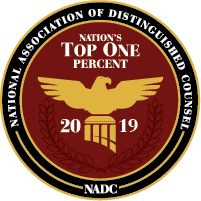This article was written by Kristi Schubert and was previously published by the Louisiana Association for Justice in its publication, “Louisiana Advocate.”
Knowledge of the interests and pressures that defense attorneys face on a daily basis can translate to better results for your plaintiff clients.
In any negotiation, the more you know about your opposition, the more likely you are to reach a favorable outcome. This is true in the zero-sum approach often used by lawyers and in a non-zero-sum approach wherein value is created by identifying mutual interests.
The economic recession of 2007-09 affected all areas of practice. For defense firms, this translates to clients with tighter budgets and, as a result, increased pressure to be productive and efficient in managing those cases in their clients’ interests.
The 2015 CLM National Litigation Management Study showed that 84 percent of participants did not believe that spending more money on the defense of a lawsuit reduces the indemnity costs of that litigation. Fewer than one out of six (16 percent) felt that spending more on defense translates to better loss-cost results. The study, which surveyed eighty chief claim and chief litigation officers, included participants like Liberty Mutual, Gallagher Bassett Services Inc., and Arch Insurance Group.
Increasingly, clients are telling defense firms that they are looking for measurable reliability and efficiency. Insurance companies and corporate clients are increasingly using legal management software to capture data about attorney performance and “metrics” to evaluate the performance of law firms and of individual attorneys within a firm.
The change is happening rapidly, and the scope is large. The Association of Corporate Counsel’s most recent “Value Challenge” promotes metrics tracking as part of a strategy to increase the predictability of outcomes and reduce overall legal spending by 25 percent. The aforementioned 2015 CLM National Litigation Management Study also revealed that 64 percent of participants are formally measuring law firm performance.
While not every firm’s metrics are being tracked, if a firm is billing a company online using task codes, there is a good chance its metrics are.
Due to the increasing focus in metrics, many defense attorneys are training their office not to be just results driven, but to be metrics driven as well. A recent webinar hosted by the Defense Research Institute (DRI) discussed the key metrics on which defense attorneys are being graded and how defense attorneys should adjust their case management strategies accordingly.
Cycle time: Close cases sooner
One of the most important metrics for defense clients is average cycle time. Cycle time refers to the number of days a case remains open. Typically, the “open date” is the date of referral or date of assignment, while the “close date” can be the date of dismissal, the date settlement agreement is reached, or, less frequently, the date the case file is officially closed.
Defense clients believe that the longer a case stays open, the more money it costs them, so they are demanding reduction in average cycle times. According to DRI members, this is the one metric they hear about repeatedly from clients. The pressure to reduce cycle time is so strong that some firms created a “cycle time bonus” to reward associates who successfully reduce their cycle time by a significant amount.
There is a long-held idea that defense attorneys have a mentality to “churn and earn” on a case. The incentive to reduce cycle times changes this to “turn and earn,” whereby the attorney is pressured to close cases as quickly as possible and get to the next one.
Staffing: Minimize high-rate billable hours
Another key metric for defense clients is “case staffing.” This metric (also referred to as an “effective” rate) looks at the billing rates for work performed on particular cases to determine what amount of time partners, associates, paralegal staff, etc., billed on a case.
Clients are incentivized to employ firms that staff their cases effectively, ensuring that each aspect of the case is handled by the staff with the lowest billable rate possible for that activity. The mantra is “pass the work off to the lowest priced competent biller.”
Clients are also using staffing metrics for diagnostic purposes. For example, if a firm bills too much for a particular type of case, the client might look at the number of hours billed at each staff level and determine that too much partner time is running up the bill.
Phasing: Decrease emphasis on early trial preparation
The “phasing” metric measures the time a firm spends on particular activities during different phases of litigation. Defense clients realize that few cases go to trial and no longer want their attorneys to focus on getting the case ready for trial early. They want their attorneys to evaluate the case and settle it as quickly as possible.
Clients prefer firms that acquire relevant information up front, allowing for quick assessment of the risks and potential value of a claim. Clients want to see that cases are front-loaded with investigation, paper discovery, and depositions. They do not want to see tasks that they consider “trial-related tasks” too early.
Decision point: Front-load discovery and investigation
Closely related to phasing, defense clients are also measuring how quickly their counsel is able to get a case to a “decision point.” Decision point means the point where the attorney has enough information to evaluate the case and make an offer to the other side.
One common way clients track when the decision point is reached is to note the date that the first mediation is set. Accordingly, attorneys may be incentivized to complete discovery and schedule depositions sooner to reduce the amount of time before reaching a decision point.
Cost per case: Average case costs are measured categorically
Defense firm clients are also measuring the average cost per case categorically, typically segmented by case type or by expected loss, to gauge performance of firms more accurately. Defense clients will categorically review their counsel’s average cost per case and compare that to costs per case achieved by competing firms or by individual attorneys within the firm.
In such an analysis, clients focus less on firms coming in under budget on a particular case. Instead, they value accurate budget projections up front. As a result, defense firms may be incentivized to operate within a budget range typically associated with that particular type of case.
Guideline compliance
Some defense clients provide their counsel with budget and litigation plan guidelines and use metrics to track how closely their counsel observes those guidelines. Frequently, this will be judged by the number of “write-offs” and “write-downs.”
Defense attorneys report that the guidelines are getting increasingly specific and that clients are going so far as to request that individual attorneys whose activities are written off or written down too often be taken off their account entirely. There are also particular activities that defense clients may want to limit. For example, defense clients did not want to see an attorney preparing for something more than once or drafting and then repeatedly revising documents.
Reporting
Reporting requirements are part of guideline compliance but are also tracked separately. Specifically, defense clients are looking to see that their counsel is making reports on time as set forth in the guidelines. This is especially important as claims handlers are being graded using reporting metrics just as the attorneys are.
A late report from an attorney may result in a claims handler’s metrics taking a hit because the handler is late getting his or her own report up the chain or because reserves are not put up or adjusted as quickly as expected.
Additionally, nearly all insurance companies have a subjective metric called “claim handler’s satisfaction,” and this metric will sometimes be used to tip the scale, all other things being equal.
Many defense clients use metrics to evaluate the performance of the firms they employ. Being familiar with these metrics and how they may influence the incentives of defense counsel may prove useful in settling your next case.










